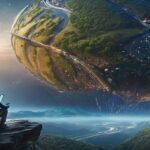In the rapidly evolving field of artificial intelligence and machine learning, the GPT series by OpenAI has steadily marked its presence, culminating in the advanced GPT-4. This marvel of technology, a significant evolution from its predecessor GPT-3, introduces heightened levels of comprehension, context understanding, and output generation. Braced with novel architectural modifications, GPT-4 wields an enhanced capacity for language processing that surpasses its earlier counterparts.
- Unraveling the technological leap, GPT-4 brings forth remarkable advancements including an increased parameter set, pioneering training techniques, and refined fine-tuning capabilities.
- Moreover, the myriad applications and use cases present a promising face of the future where GPT-4 could potentially alter the course of industries.
However, with such advancement, come complex ethical challenges. From privacy to risk misuse, there are major considerations to address. Despite these concerns, with effective measures, the safe use of GPT-4 can be ensured. This daunting journey from GPT-3 to GPT-4 sets the stage for our discussion, paving the way to explore new frontiers in AI and machine learning.
Evolution from GPT-3 to GPT-4
In the compelling and rapidly advancing world of artificial intelligence (AI), OpenAI’s Generative Pretrained Transformer 4 (GPT-4) has ushered in what can be described as a new chapter in the exploration of machine learning and natural language processing. To fully appreciate the innovation inherent to GPT-4, it’s key to first understand its predecessor, GPT-3.
GPT-3, a language prediction model, was released by OpenAI in June 2020. Built on larger neural networks than its previous iterations, it owned the capability to generate human-like text, answering questions, translating languages, and even composing poetry. With 175 billion parameters, GPT-3 astounded scholarly and commercial arenas with its ability to generate high-quality text that closely mirrored human writing.
Compared to GPT-3, GPT-4 brings a myriad of improvements to the table, a testament to the relentless pursuit of discovery in the field of AI.
For starters, one of the remarkable points of evolution is likely to be seen in the processing power of GPT-4. While details around GPT-4 are still emerging, expectations thus far are geared towards a mode with significantly more than the 175 billion parameters that GPT-3 boasts. This enhances the model’s understanding of context and promotes more accurate and nuanced text generation.
Moreover, GPT-4 is anticipated to provide a noticeable uplift in text understanding and generation by focusing on alleviating some of GPT-3’s limitations. For instance, while GPT-3 excels in imitating human-like text, it can sometimes output nonsensical or irrelevant responses or falter with complex or nuanced prompts. Improving on these dimensions will uphold the foundational promise of AI: to support and facilitate human endeavors effectively and reliably.
Another key frontier for GPT-4’s evolution is its training on a larger and more diverse dataset. A broader range of data ensures a wider understanding of languages and cultures, thus helping the model generate linguistically and contextually accurate responses. Consequently, an even more engaging and empathetic interaction with AI becomes possible.
Notably, there’s an expected emphasis on ethical AI and reducing bias in GPT-4’s design and output. GPT-3, like many AI models, faced challenges relating to bias and sensitivity in its interactions. Ensuring that GPT-4 is ethical and unbiased is not just a technological necessity, but a socio-cultural imperative as well. It is hoped that OpenAI will invest significantly in minimizing harmful and unfair bias, making AI an open platform for all users.
In conclusion, GPT-3 was an impressive leap ahead in the AI sector, and GPT-4 is expected to pave the way forward with improved scale and scope for AI’s understanding and interaction. Indeed, the evolution of this technology proves that the journey into the heart of AI and machine learning remains an unending quest for perfection, an adventure both exhilarating and brain-tingling.

Technological Enhancements in GPT-4
The ever-evolving hemisphere of artificial intelligence technology augments our knowledge and challenges our capacities. Undeniably, the forthcoming iteration of OpenAI’s language model, GPT-4, denotes an important juncture in this progressive trajectory. Building on the bedrock already forged by its predecessor, GPT-3, GPT-4 capitalizes on paramount augmentations specifically honed to advance its predictive language and text generation capabilities.
One of the key advancements with GPT-4 is a superior encoding-design process. It’s a known phenomenon that the ability of a language model to grasp different languages and narratives increases with a rise in parameters. OpenAI’s research team has made an arduous effort to enhance GPT-4’s transformer network, a system of layers that interprets and responds to inputs. The intricate design encodes greater context from the vast datasets it’s trained on, facilitating a more dynamic response mechanism. This versatility interprets a broader context, finetuning a more balanced and fluent language model embodying an advanced form of clarity, coherency, and relevance in its responses.
Another significant development engineered into GPT-4 is its innovative approach towards enhancing the model’s comprehension skills. By methodical restructuring of the existing knowledge-primed encoding layers and the implementation of diverse databases during training phases, the GPT-4 model endeavors to achieve a more humane understanding of ambiguous or complex prompts. This is not just limited to understanding contexts but also includes the capability to deduce the emotional-tone and sarcasm from the inputs, thereby making the resulting communication interaction more ‘human-like’.
Committed to ethical AI, OpenAI has constructed GPT-4 aiming to control and narrow down harmful or unfair bias. To mitigate complexities, the team has integrated renovations at the peg of the model’s architecture by applying intricately developed bias screens during the training phase. Such advancements help the model differentiate non-factual, offensive or discriminative content thereby reducing the risk of intellectual-inequity and encouraging ethical use of AI technology.
OpenAI’s dedication to pioneering advancements in AI is abundantly clear with GPT-4, a standing testament to their aspiration towards using AI for the service of mankind. The role of GPT-4 in furthering the field of AI and Machine Learning is significant and its forthcoming performance is eagerly awaited by those versed in the realms of artificial intelligence, machine learning, and beyond. These technological improvements not only crystallize the capabilities of GPT-4 but also underline the robust progress of AI technology as a whole.

Potential applications and use-cases of GPT-4
Unfolding the Landscape of GPT-4 Applications
Post delineation of GPT-4’s salient features, our gaze now shifts onto its potential applications and use cases, shedding light upon nascent avenues where it could significantly mark its imprint.
The first arena to highlight is personalized education. GPT-4 can personalize educational content by understanding individual learning styles and pace. Its refined language prediction ability can potentially create comprehensive syllabuses, generate insightful quizzes, or even answer queries in real time, thus fulfilling the vision of an AI tutor available round-the-clock.
In the realm of business, GPT-4 stands promisingly capable of unearthing actionable insights from extensive data sets with its enhanced data processing prowess. It could additionally automate routine tasks, such as drafting emails or generating reports, thereby streamlining workflows and supporting an increased focus on strategic planning and implementation.
Healthcare, too, can anticipate revolutionary advancements with GPT-4. Its potential to condense colossal volumes of medical literature into accessible summaries for practitioners is tantamount to creating a knowledgeable medical assistant, that could empower healthcare professionals in enhancing the quality of care.
GPT-4 might also transform customer service, by enabling more nuanced interactions through chatbots infused with empathetic and contextually accurate responses. Predictably, GPT-4 might become an indispensable tool for customer relationship management, expediting service delivery without compromising communicative warmth.
Moreover, for closed-captioning and transcription services, GPT-4’s improved context understanding could mean higher accuracy rates. This will help differently-abled individuals to engage with media content more effectively, thereby fostering inclusivity.
Remarkably, GPT-4’s potential isn’t confined to the domains delineated above. From enhancing virtual reality with immersive storytelling to astutely analyzing legal contracts or even generating creative content in literature, movies, or music, GPT-4’s capacity to revolutionize various fields appears profoundly expansive.
Fundamentally, these applications speak to GPT-4’s underlying promise: augmenting human capabilities rather than supplanting them. Its monumental computational power serves to empower human intellect, freeing it from mundane tasks to focus on pursuits of creativity and strategic thinking.
The unfolding journey of GPT-4 is an exciting narrative on the synergy of artificial intelligence and human potential. It affirms the reality that AI, in its truest sense, isn’t about creating machines that think like humans, but about designing technology that can work with humans, in an enhanced and elevated capacity. Immeasurable are the applications of GPT-4 hovering on the horizon, and the world keenly awaits its unveiling.

Ethical considerations and challenges with GPT-4
Consequent to the information provided, a serious discourse is warranted upon the ethical enigmas and challenges that emerge with the application of GPT-4. This encapsulates the quandaries within privacy, accessibility, misuse, and potential existential risks.
Privacy has always been a cornerstone of ethical discussions concerning any data-intensive technology. With GPT-4’s advanced language generation capabilities, privacy risks drive concern, particularly regarding the handling of sensitive data. The intellectual might of GPT-4 could interpret information in myriad unexpected ways. It can potentially learn from and replicate personal writing styles, thereby adding a new facet to the privacy dilemma.
Accessibility, while considered mostly a boon, poses noteworthy ethical challenges. With intended widespread access to the benefits of GPT-4, also comes higher risks of misuse. By expediting the tasks of writing, analyzing, and generating text, it elevates possibilities of leveraging this technology for misinformation, fabrication, and spam. Consequently, the onus of balancing utility against abuse of such potent technology presents itself as a formidable task.
Adding to the convolution, the widespread application of GPT-4 beckons an examination of power dynamics. Much like other aspects of artificial intelligence, the development and control of such transformative technology may concentrate primarily within powerful organizations. This might lead to an imbalance, raising questions about the fair distribution of information and knowledge.
Lastl, one cannot dismiss the existential risks associated with any trailblazing technology. With its capacity to generate increasingly sophisticated texts, there arises the hypothetical risk of AI takeover in the realm of human-led intellectual tasks. If and when AI can automate all human intellectual tasks, it’s crucial to explore the ethical implications pertaining to employment, human purpose and value.
Supplementing OpenAI’s efforts to imbibe ethical practices and unbiased results in GPT’s designs, the broader scientific community must diligently foster ethical precautions. This implies widespread responsibility, not restricted to AI researchers and developers alone. Policymakers, societal stakeholders, and thought leaders must play an active role in safeguarding against ethical damages, instituting stringent regulations if necessary.
Currently, comprehensive understanding of all the potential applications and implications of GPT-4 is confined by our limited knowledge. As OpenAI continues to deepen our understanding of how this technology can be responsibly managed, lessons learned will pave the path for AI advancement globally. These aspects underscore the profound charm and consequence of engaging with artificial intelligence, constantly challenging us to commingle our passionate exploration with the prudential gaze of ethical responsibility.

Future of AI and Machine Learning with GPT-4
The promise of GPT-4’s technical advancements extends far beyond the simplicity of language model transformation. By augmenting human intelligence with machine learning, GPT-4 can aid in accelerating discovery. Experiment designs, hypothesis formulation, and even analysis of scientific data stands to be significantly streamlined. Consequently, this expansion of AI assistance could initiate a profound paradigm shift amongst scholars, akin to the advent of the modern computer.
In social sciences, qualitative research might witness a renaissance. GPT-4’s improved predictive text capabilities can handle large volumes of complex datasets. Sorting through participant testimonies, case studies, and anonymized conversations could be achieved with greater efficiency than ever before. For those in natural sciences, AI could survey countless numbers of scholarly articles to extract patterns and relationships humans might overlook.
Within the legal sphere, GPT-4 could simplify document analysis and contract verification, significantly reducing time spent on these tasks. Multilingual translations, expedited through the AI model, would break down language barriers, enhancing international collaboration and negotiation.
As with all advancements, oversight is paramount. OpenAI’s transparency in sharing their ambition and commitment to monitoring any misuse of their technology is commendable. Ensuring ethical use, regulating access, and fostering a healthy exchange of ideas around these advancements can make all the difference.
Integrating GPT-4 into artistic fields such as music and literature promises revolutionary change. Imagine if AI could assist a musician in composing a symphony, considering factors from chord progressions to emotions. Literature, too, stands to gain, with AI’s ability to aid in plot development or character creation. Crucial though, is maintaining an environment where AI serves as tools for the artist, and not replacements.
It is also worth considering the potential for misappropriation and misuse of this powerful technology. GPT-4’s advanced language abilities might be leveraged for deceptive purposes, such as deepfake text production, or cyber impersonation. It’s an evolving frontier that continues to raise valid questions about user privacy, biases, and the potential to influence society on a mass scale.
In conclusion, GPT-4 represents a leap forward in AI and machine learning technologies, with profound potential impacts across industries and facets of society. OpenAI’s transparency in sharing details of GPT-4’s framework is key in fostering open dialogue on the ethical implications of these advancements. As professionals in the field, we must shoulder the shared responsibility of guiding GPT-4’s development while minimizing its risks – nurturing the growth of this remarkable technology, while preserving the societal values we hold dear.

GPT-4’s profound impact on the field of AI and machine learning indicates a transformative future. It signifies a leap in the realms of neural networks and natural language processing, potentially becoming the cornerstone of future advancements. However, its implementation will not be without challenges.
- From the diverse applications and use-cases, it is clear that GPT-4 bears the potential to reshape various sectors.
- However, this remarkable tool kit should be used with scrutiny, understanding the associated ethical implications and employing measures to mitigate risks.
As we prepare for a world increasingly reliant on AI, understanding, and adapting to technologies such as GPT-4 will be crucial. A fine balance between leveraging its potential benefits and mitigating associated risks will define the trajectory of its success.



